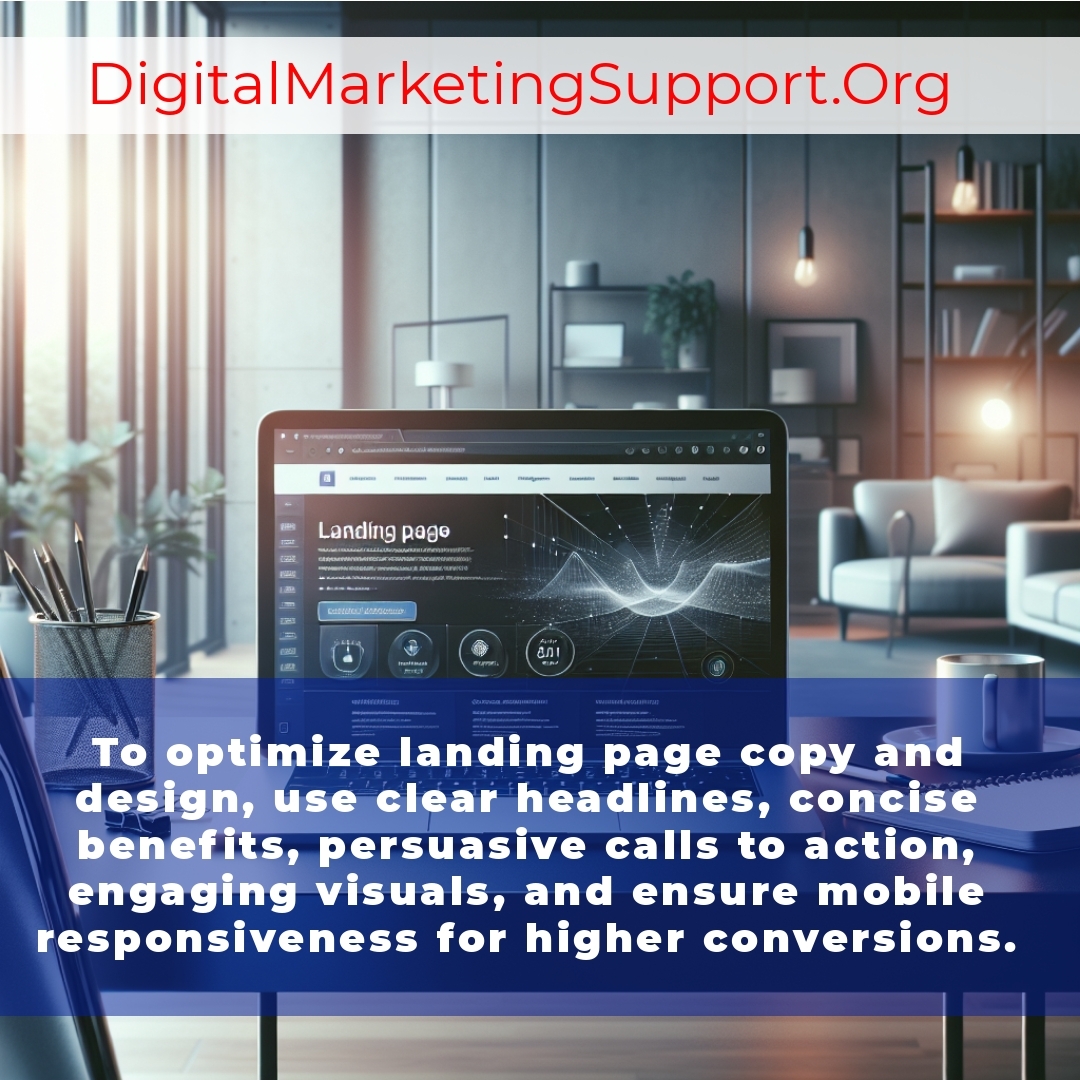In the digital marketing landscape, an optimized landing page is crucial for capturing visitor attention and driving conversions. By learning how to optimize landing page elements effectively, you can significantly boost your conversion rates. This article provides essential strategies for crafting compelling copy and designing engaging layouts that lead to higher conversions.
“Craft clarity in your words, and conversions will follow.”

Understanding the Basics of Landing Page Optimization
Optimizing your landing page is all about making sure it’s set up to convert visitors into customers effectively. When you optimize a landing page, you enhance its ability to engage users and drive them towards a specific action, whether that’s making a purchase, signing up for a newsletter, or any other goal. The significance of this process can’t be overstated, as even small improvements can lead to significant increases in conversion rates.
Key Elements That Affect Conversion Rates
Several key elements influence how well your landing page converts. These include the headlines, copy, design, images, call to actions, and overall user experience. Each of these components plays a vital role in guiding the visitor towards taking the desired action. By focusing on optimizing each of these elements, you can create a more compelling and effective landing page that drives higher conversions.
Crafting Compelling Landing Page Copy
Your landing page copy is crucial because it communicates your message and persuades visitors to take action. Effective landing page copy should be clear, concise, and focused on the benefits your product or service offers. It needs to resonate with your target audience and address their needs and pain points.
Techniques for Writing Persuasive Headlines and Body Text
Start with a strong headline that grabs attention and clearly states the value proposition. Use actionable language and highlight the main benefit. In the body text, keep sentences short and to the point. Use bullet points to break up information and make it easy to digest. Incorporate storytelling elements to make your copy more relatable and engaging.
Headline Effectiveness: How to Grab Attention
A powerful headline is essential for capturing your audience’s attention. It should be compelling and relevant, making visitors want to learn more. Use strong, emotional words and address the primary benefit or solution your landing page offers. Testing different headlines through A/B testing can help determine which ones are most effective.
Incorporating Trust Signals to Build Credibility
Trust signals like testimonials, reviews, and security badges can significantly enhance your landing page’s credibility. Including these elements helps reassure visitors that your offering is reliable and trustworthy. Displaying real customer feedback and certifications can build trust and encourage more conversions.
How to Optimize Landing Page Copy for Higher Conversions
To optimize landing page copy for higher conversions, focus on clarity and relevance. Ensure that your message aligns with the visitor’s intent and that the benefits are clearly highlighted. Use keywords naturally and maintain a conversational tone to engage your audience effectively.
Designing a High-Converting Landing Page
The design of your landing page plays a crucial role in conversion rates. A well-designed landing page not only looks appealing but also guides users seamlessly towards taking action. Good landing page design involves balancing aesthetics with functionality to create an engaging user experience.
Best Landing Page Design Practices to Increase Conversions
Implementing best design practices can significantly boost your landing page’s effectiveness. Use a clean and uncluttered layout, ensuring that key elements stand out. Employ a consistent color scheme and typography that aligns with your brand. Make sure that your call to action is prominently displayed and easy to find.
Responsive Design and Mobile Optimization for Better User Experience
With the increasing use of mobile devices, ensuring your landing page is mobile-friendly is essential. Responsive design automatically adjusts your page layout to fit different screen sizes, providing a seamless experience for all users. Mobile optimization not only improves user experience but also positively impacts your SEO rankings.
Utilizing Visual Hierarchy to Guide User Attention
Visual hierarchy helps guide users’ attention to the most important parts of your landing page. By strategically placing elements like headlines, images, and call to actions, you can direct visitors’ focus and encourage them to take the desired action. Use size, color, and placement to create a clear visual path.
Ensuring Fast Page Load Speed to Reduce Bounce Rates
Page load speed is a critical factor in user experience and conversion rates. Slow-loading pages can lead to higher bounce rates as visitors lose patience and leave. Optimize your images, leverage browser caching, and minimize the use of heavy scripts to ensure your landing page loads quickly and efficiently.
Enhancing User Experience (UX)
User experience is at the heart of landing page optimization. A positive UX ensures that visitors can navigate your page effortlessly and find the information they need without frustration. Enhancing UX can lead to higher engagement and increased conversions.
Tips for Improving Landing Page User Experience
To improve user experience, simplify your navigation and make it easy for users to find what they’re looking for. Use clear and concise language, and avoid unnecessary distractions that can detract from your main message. Ensure that your landing page is visually appealing and that all elements work together harmoniously.
Simplifying Navigation and Minimizing Distractions
A straightforward navigation structure helps visitors focus on your key message without getting sidetracked. Remove any elements that don’t serve a clear purpose, and guide users smoothly towards your call to action. Minimalist design can help reduce cognitive load and keep users engaged.
Effective Call to Action (CTA) Strategies
Your call to action is one of the most important elements of your landing page. It directs users to take the next step, whether that’s making a purchase, signing up for a newsletter, or downloading a resource. Crafting compelling CTAs is essential for driving higher conversions.
Strategies for Effective Call to Action on Landing Pages
To create effective CTAs, use clear and action-oriented language that tells users exactly what to do. Make your CTAs stand out by using contrasting colors and ensuring they are prominently placed on the page. Test different variations to see which ones resonate best with your audience.
Placement and Design of CTAs for Maximum Impact
The placement and design of your CTAs can significantly impact their effectiveness. Position CTAs in areas where they are easily visible, such as above the fold or at the end of compelling sections. Use design elements like buttons and arrows to draw attention to your CTAs and encourage clicks.
Conversion Rate Optimization Techniques
Conversion rate optimization (CRO) involves systematically improving your landing page to increase the percentage of visitors who take the desired action. This process requires a deep understanding of user behavior and continuous testing to identify what works best.
Techniques for A/B Testing Landing Page Elements
A/B testing is a powerful technique for CRO, allowing you to compare different versions of your landing page to see which performs better. Test elements such as headlines, images, copy, and CTAs to determine which variations lead to higher conversions. Use the data collected to make informed decisions and refine your landing page accordingly.
Analyzing Data to Make Informed Design and Copy Decisions
Data analysis is crucial for understanding how visitors interact with your landing page. Use analytics tools to track metrics like bounce rate, time on page, and conversion rate. Analyze this data to identify patterns and trends, and use these insights to optimize your design and copy for better performance.
Building Trust and Credibility
Building trust and credibility is essential for convincing visitors to take action on your landing page. When users trust your brand, they are more likely to convert. Incorporate elements that enhance your credibility and reassure visitors of your reliability.
Incorporating Trust Signals Such as Testimonials and Reviews
Testimonials and reviews are powerful trust signals that can help build credibility. Display positive feedback from satisfied customers to show that others have had a good experience with your product or service. Real testimonials make your claims more believable and relatable.
Displaying Security Badges and Certifications
Security badges and certifications can reassure visitors that their personal information is safe and that your business is legitimate. Displaying these elements prominently on your landing page helps build trust and reduces any hesitation users might have about converting.
Case Studies and Success Stories to Enhance Credibility
Case studies and success stories provide detailed examples of how your product or service has benefited others. Sharing these stories helps potential customers see the real-world value of what you offer and can significantly enhance your credibility and trustworthiness.
Optimizing for Mobile Users
With more people accessing the internet via mobile devices, optimizing your landing page for mobile users is more important than ever. A mobile-optimized landing page ensures that all visitors have a smooth and enjoyable experience, regardless of the device they use.
Best Practices for Designing Mobile-Friendly Landing Pages
Design your landing page with a mobile-first approach. Use a responsive design that adapts to different screen sizes and orientations. Ensure that text is readable without zooming, buttons are easy to tap, and images load quickly. Simplify your layout to focus on the most important elements for mobile users.
Ensuring Seamless User Experience Across All Devices
A seamless user experience across all devices means that your landing page functions perfectly whether viewed on a desktop, tablet, or smartphone. Test your landing page on various devices and browsers to ensure consistency
Conclusion
Optimizing your landing page copy and design is essential for achieving higher conversions. By focusing on compelling copy, effective design, enhancing user experience, and employing strategic call to actions, you can significantly improve your landing page’s performance. Implementing these strategies will help you build trust, engage your audience, and ultimately drive more conversions.
Remember, continuous testing and data analysis are key to effective conversion rate optimization. By regularly refining your landing page based on user behavior and feedback, you can maintain and even boost your conversion rates over time. Start applying these optimization techniques today to see measurable improvements in your landing page performance.
Additional Tips
– Prioritize readability and flow throughout the landing page to keep visitors engaged.
– Use keyword variations and synonyms to maintain natural language and avoid keyword stuffing.
– Balance keyword density to enhance SEO without compromising content quality.
– Place important keywords in headings, subheadings, and within the first 100 words of your content to improve search engine rankings.
FAQ
What is landing page optimization?
Landing page optimization is the process of improving a web page to increase the percentage of visitors who convert into customers. This involves making changes to the design, copy, and overall user experience to enhance engagement and drive specific actions.
Why is a strong headline important?
A strong headline grabs attention and clearly expresses the value of your offering. It’s crucial for drawing visitors in and encouraging them to read further and take action.
What role do trust signals play in landing page optimization?
Trust signals, such as testimonials, reviews, and security badges, help build credibility and reassure visitors that your product or service is reliable, increasing the likelihood of conversion.
How can I improve the user experience on my landing page?
To enhance user experience, simplify navigation, use clear language, and minimize distractions. A visually appealing layout and cohesive design will also help keep visitors engaged.
What are effective strategies for creating CTAs?
Use clear, action-oriented language and make your CTAs stand out through contrasting colors and prominent placement. Testing different versions can help identify what works best for your audience.
How can I track the performance of my landing page?
Utilize analytics tools to monitor metrics like bounce rate, time on page, and conversion rate. Analyzing this data will help you identify patterns and make informed design and copy decisions.
What are the best practices for mobile optimization?
Adopt a mobile-first design approach, ensuring your landing page is responsive. Ensure text is readable, buttons are easily tappable, and images load quickly for a seamless mobile experience.
How often should I conduct A/B testing?
Regularly conduct A/B testing whenever you make significant changes to your landing page. Continuous testing helps refine your approach and improve conversion rates over time.
What should I include in my landing page copy?
Focus on clear, concise language that highlights the benefits of your product or service. Use actionable language, bullet points for easy reading, and storytelling elements to engage your audience.








